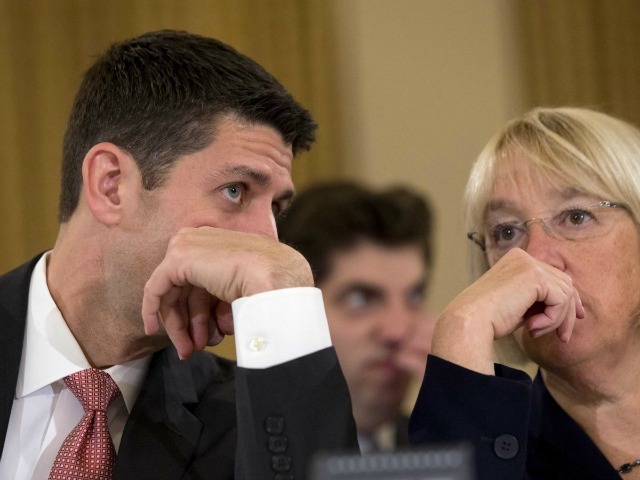(Source: AP)
Channeling the spirit of the holiday season, key lawmakers managed to set aside dysfunction and take the first step in a small budget deal for the 2014 fiscal year.
Back in October, Congress ended the 16-day government shutdown that cost this country 120,000 jobs by appointing a 29-member, bipartisan Budget Conference Committee to broker federal spending levels.
| The Murray-Ryan deal falls far short of what’s needed to get our spending priorities right. |
This was a necessary first step to passing a budget by Jan. 15, the expiration date they set for the stop-gap spending bill that’s currently funding the government.
Upon releasing so-called top-line spending figures for fiscal years 2014 and 2015, Budget Committee Co-Chairs Representative Paul Ryan and Senator Patty Murray announced that they successfully crossed the first milestone.
While their agreement is an important step toward bipartisanship and away from manufactured crises, it leaves a lot of congressional business unfinished—including unemployment insurance, food stamps, and the debt ceiling. It also leaves a lot to be desired as it lacks most of the things that Americans say they want.
There’s broad agreement among the general public about what a budget deal should contain and as we move into the budget debates for fiscal year 2015, let’s hope that our lawmakers finally pay attention to what they missed in this deal.
National polls routinely indicate that Americans want Social Security strengthened, with 82 percent choosing to preserve benefits even if it means raising taxes. As lawmakers move forward, they should listen to the American people and eliminate the $113,700 taxable limit on wages subject to Social Security taxes to strengthen and secure the program for generations to come.
When it comes to the Pentagon, Americans favor cuts, with voters on average choosing an 18 percent reduction in military spending when they’re presented with information about current spending levels.
Yet each year the military accounts for more than half of all discretionary spending approved by Congress. It’s imperative that lawmakers heed the advice of a bipartisan task force that found $1 trillion in fat over the next 10 years hiding in the Pentagon budget—and start making intelligent reductions.
The Murray-Ryan deal raises revenue largely through fees and does not contain a penny of new tax revenue, even though 80 percent of Americans want to see higher taxes on corporations. Meanwhile 66 percent of Americans want tax loopholes closed for the wealthy.
And these loopholes add up to big bucks—they cost the U.S. Treasury hundreds of billions of dollars each year. In 2013 alone, the tax break for offshore corporate profits, known as “deferral,” cost the U.S. Treasury $42 billion. That’s five times as much as the federal government spent on the early-childhood program Head Start over the course of this year.
The tax break for capital gains and dividends income—which overwhelmingly benefits the top 1 percent of taxpayers—cost the Treasury a whopping $83 billion in 2013. That’s more than the entire food stamp program, which both chambers of Congress appear poised to cut next year.
During closed-door Budget Committee negotiations we routinely heard from our lawmakers that the federal budget is “in crisis.” To use a phrase that Vice President Joe Biden made famous in last year’s vice presidential debates, that’s a bunch of a malarkey.
The federal budget’s crisis is being caused by our elected officials, who have failed to fulfill their responsibility of passing a spending and revenue plan that reflects the people’s values and priorities. There’s plenty of common ground for what that plan should contain.
Just following the wishes of the American people would strengthen Social Security, make smart spending cuts, and raise needed tax revenue.,
The Budget Committee legislation tweaked the edges of the federal budget instead of coming up with real solutions. Americans deserve better.
Mattea Kramer is Research Director at National Priorities Project and the lead author of A People’s Guide to the Federal Budget. She writes for OtherWords, where this originally appeared.







0 Comments